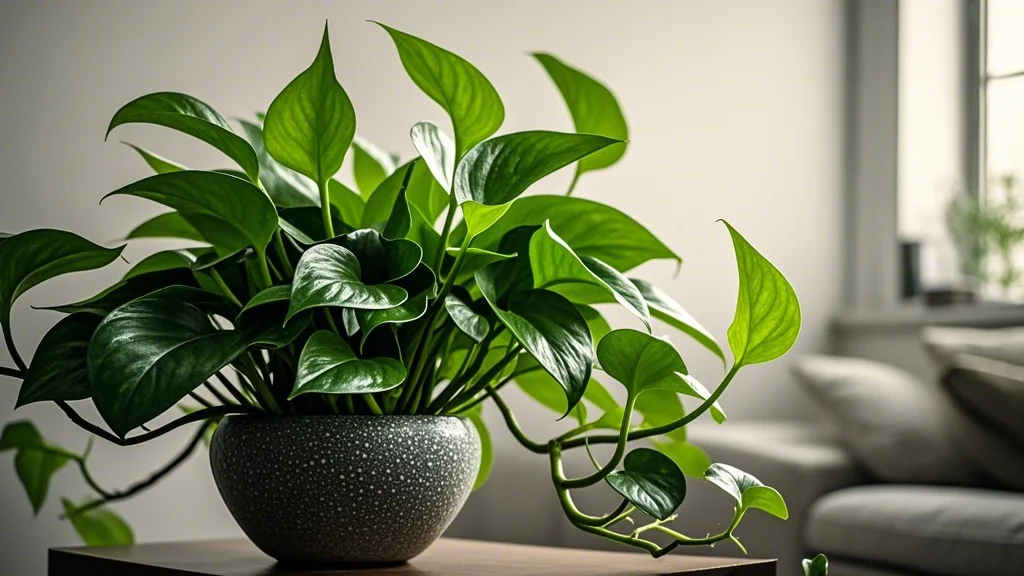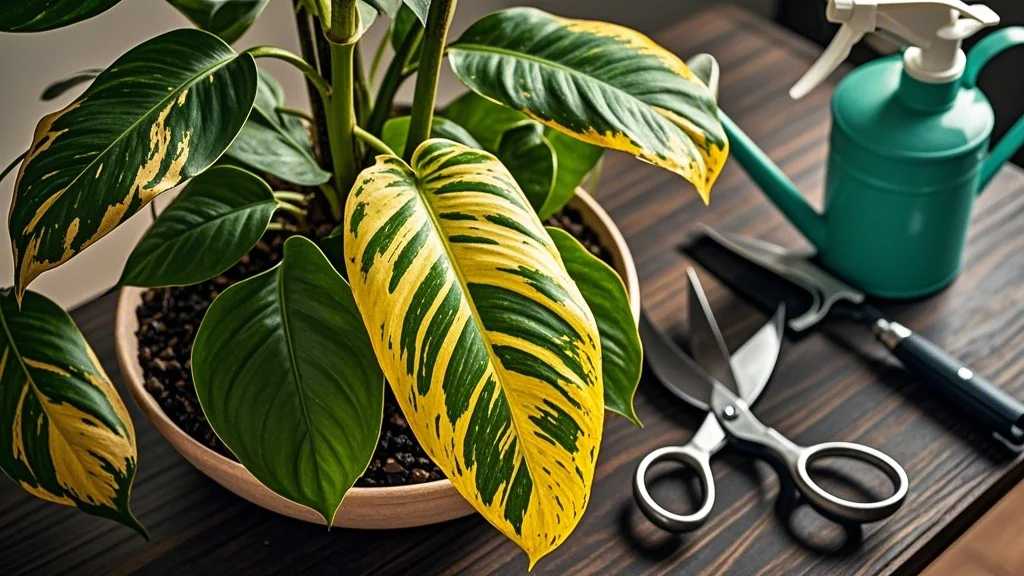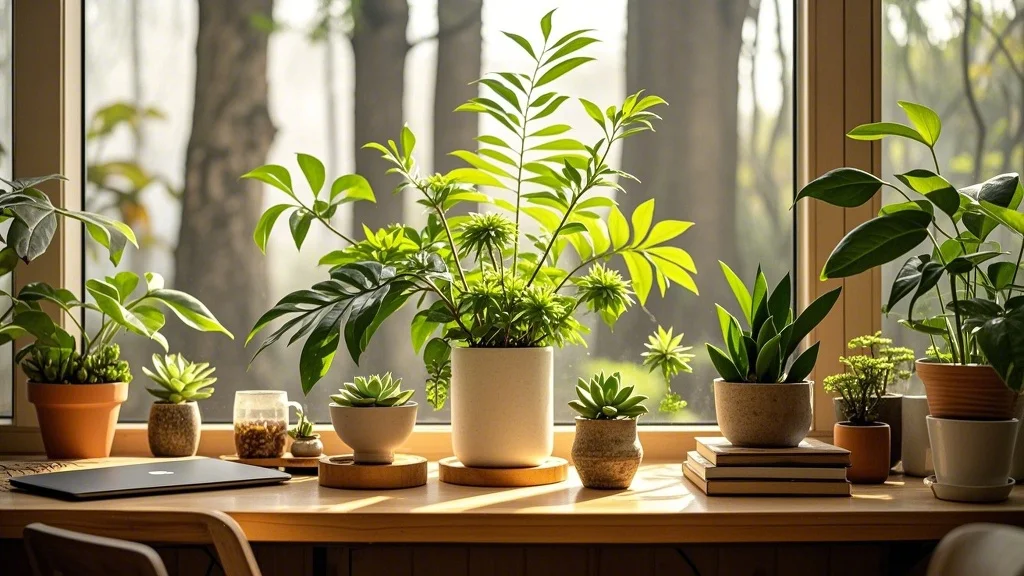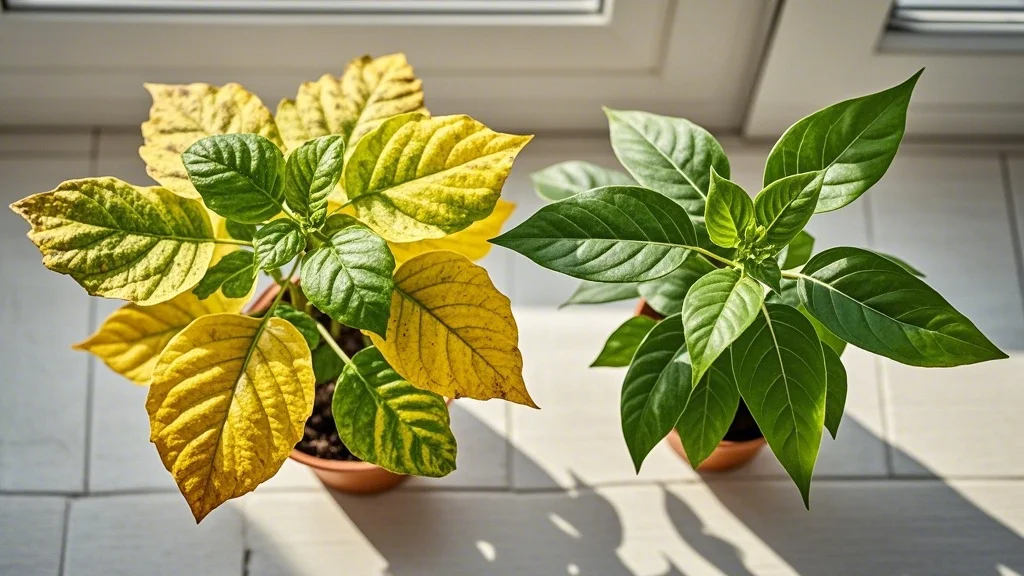Indoor plants bring life, color, and a touch of nature into our urban homes. However, caring for houseplants can sometimes feel overwhelming, especially for beginners. At OwnGardens, we receive numerous questions about indoor plant care daily. This comprehensive guide addresses the most common queries to help you become more confident in nurturing your green companions.
Contents
Watering Questions

How often should I water my indoor plants?
There’s no one-size-fits-all answer as watering needs vary significantly between plant species and are affected by environmental factors. Instead of following a strict schedule:
- Check the soil moisture by inserting your finger 1-2 inches deep—water when it feels dry
- Consider your plant’s natural habitat—desert plants need less water than tropical varieties
- Adjust for seasonal changes—most plants need less water in winter
- Pay attention to environmental factors like humidity, temperature, and light exposure
As a general guideline, most common houseplants prefer to dry out slightly between waterings rather than staying constantly moist.
How can I tell if I’m overwatering or underwatering?
Signs of overwatering:
- Yellowing leaves throughout the plant
- Soft, mushy stems or leaves
- Brown spots with yellow halos
- Moldy soil surface
- Fungus gnats presence
- Root rot (dark, mushy roots)
Signs of underwatering:
- Crispy, brown leaf edges
- Curling or drooping leaves
- Slow growth
- Dry, pulling-away soil
- Leaves falling off easily
- Wilting that doesn’t recover after watering
Should I use tap water for my plants?
Tap water can be suitable for many houseplants, but it often contains chlorine, fluoride, and minerals that may affect sensitive species. Consider these options:
- Let tap water sit out overnight to allow chlorine to evaporate
- Use filtered water for sensitive plants like calatheas, spider plants, and dracaenas
- Collect rainwater as a natural, chemical-free alternative
- Consider distilled water for extremely sensitive plants, though it lacks minerals
What’s the best way to water indoor plants?
For most plants, thorough watering until water drains from the bottom is ideal:
- Water slowly and evenly around the soil surface
- Continue until water flows from the drainage holes
- Allow excess water to drain completely—never let plants sit in standing water
- Empty saucers or cache pots within 30 minutes
For plants that prefer consistent moisture, bottom watering can be effective:
- Place the pot in a container with 1-2 inches of water
- Allow the soil to absorb water through the drainage holes for 15-30 minutes
- Remove the plant and let excess water drain
Light Requirements
How much light do indoor plants need?
Light requirements vary by species, but understanding these general categories helps:
High light plants (6+ hours of direct sunlight):
- Succulents, cacti
- Crotons
- Fiddle leaf figs
- Most flowering houseplants
Medium light plants (bright indirect light):
- Pothos
- Philodendrons
- Monstera
- Peace lilies
- Snake plants
Low light plants (can tolerate minimal natural light):
- ZZ plants
- Cast iron plants
- Some ferns
- Certain varieties of pothos and philodendron
Remember that “low light” doesn’t mean “no light”—all plants need some light for photosynthesis.
What’s the difference between direct and indirect light?
Direct light: Sunlight that shines directly onto your plants without obstruction, creating distinct shadows. South and west-facing windows typically provide direct light.
Indirect light: Sunlight that’s filtered or reflected before reaching your plants. This can be achieved through sheer curtains, positioning plants a few feet away from windows, or placing them near north or east-facing windows.
Can I use artificial lights for my plants?
Absolutely! Grow lights are excellent for supplementing natural light, especially in winter or in spaces with limited windows:
-
LED grow lights are energy-efficient and can be customized for specific plant needs
-
Full-spectrum lights mimic natural sunlight and support all stages of plant growth
-
Fluorescent lights work well for low to medium light plants and seedlings
When using grow lights:
- Position them 6-12 inches above plants (distance varies by light intensity)
- Provide 12-16 hours of light daily
- Consider using timers for consistency
Soil and Potting
How often should I repot my indoor plants?
Most houseplants benefit from repotting every 1-2 years, but consider these indicators:
- Roots growing through drainage holes
- Roots circling visibly at the soil surface
- Water running straight through the pot without being absorbed
- Significantly slowed growth despite proper care
- Plant becoming top-heavy or unstable
The best time to repot is usually in spring or early summer when plants are actively growing.
What type of soil should I use for indoor plants?
Different plants have different soil preferences:
Standard houseplants (pothos, philodendrons, peace lilies):
- Quality all-purpose potting mix with added perlite for drainage
Succulents and cacti:
- Fast-draining cactus mix or regular potting soil amended with coarse sand and perlite
Orchids:
- Specialized orchid mix containing bark, charcoal, and sphagnum moss
African violets:
- Light, porous African violet mix or peat-based potting mix
Avoid using garden soil for indoor plants as it’s too dense and may contain pests or diseases.
Do indoor plants need fertilizer?
Yes, container plants eventually deplete nutrients in their limited soil. Consider these fertilizing guidelines:
- Most houseplants benefit from fertilizing during active growth (spring and summer)
- Reduce or eliminate fertilizer during dormant periods (fall and winter)
- Use balanced, water-soluble fertilizers at half the recommended strength
- Organic options include worm castings, compost tea, and fish emulsion
- Always fertilize moist soil to prevent root burn
Remember that under-fertilizing is generally safer than over-fertilizing, which can damage roots and leaves.
Common Plant Problems

Why are my plant’s leaves turning yellow?
Yellowing leaves can indicate several issues:
-
Overwatering: The most common cause—check for soggy soil and adjust watering
-
Underwatering: Usually accompanied by crispy leaf edges and drooping
-
Light issues: Too much or too little light can cause yellowing
-
Nutrient deficiencies: Particularly nitrogen, which causes older leaves to yellow first
-
Temperature stress: Exposure to drafts or temperature extremes
-
Natural aging: Older leaves naturally yellow and drop, especially from the bottom of the plant
Examine the pattern of yellowing and accompanying symptoms to determine the cause.
How do I get rid of pests on my houseplants?
Common houseplant pests include spider mites, mealybugs, scale, fungus gnats, and aphids. Here’s a general approach:
-
Isolate the affected plant to prevent spreading
-
Identify the specific pest to determine the best treatment
-
Manual removal: Wipe leaves with a damp cloth or use a cotton swab with rubbing alcohol for visible pests
-
Spray with insecticidal soap or neem oil solution, covering all plant surfaces including leaf undersides
-
Repeat treatments every 7-10 days for at least three applications
-
Preventative measures: Regular leaf cleaning, proper watering, and good air circulation
For severe infestations, you may need to prune heavily affected areas or, in extreme cases, discard the plant.
Why are the leaf tips of my plants turning brown?
Brown leaf tips typically indicate:
-
Low humidity: Most common in winter or in air-conditioned spaces
-
Inconsistent watering: Allowing plants to dry out too much between waterings
-
Salt buildup: From fertilizers or minerals in tap water
-
Direct heat exposure: From heating vents or radiators
-
Chemical sensitivity: Particularly to fluoride or chlorine in tap water
Solutions include increasing humidity with pebble trays or humidifiers, maintaining consistent watering, flushing the soil occasionally with distilled water, and keeping plants away from heat sources.
Humidity and Temperature
How can I increase humidity for my tropical plants?
Tropical plants like ferns, calatheas, and many philodendrons thrive in higher humidity. Try these methods:
-
Group plants together to create a microclimate with higher humidity
-
Use pebble trays: Place plants on trays filled with water and pebbles (keep the pot above water level)
-
Run a humidifier near your plants, especially in winter
-
Mist sensitive plants in the morning (though this provides only temporary humidity)
-
Place plants in naturally humid areas like bathrooms or kitchens
-
Create a terrarium for small humidity-loving plants
What’s the ideal temperature for houseplants?
Most common houseplants are tropical or subtropical in origin and prefer:
- Daytime temperatures between 65-75°F (18-24°C)
- Nighttime temperatures about 10°F cooler
- Protection from sudden temperature fluctuations
- No exposure to cold drafts or hot air from vents
Be mindful of window placement—leaves touching cold windows in winter can suffer damage, and south-facing windows can become too hot in summer without proper shading.
Propagation
How can I propagate my houseplants?
Propagation methods vary by plant type:
Stem cuttings (pothos, philodendron, monstera):
- Cut a 4-6 inch section below a node (where leaves attach)
- Remove lower leaves, leaving 2-3 at the top
- Place in water or moist soil
- Keep warm and in bright indirect light until roots develop
Leaf cuttings (snake plants, succulents):
- Cut a healthy leaf into 2-3 inch sections
- Let succulent leaves callus for 1-2 days
- Place cut end in soil or lay flat on soil surface
- Keep slightly moist until new growth appears
Division (peace lilies, ZZ plants, spider plants):
- Remove the plant from its pot
- Gently separate the root ball into sections, ensuring each has roots and stems
- Repot divisions in fresh soil
- Water thoroughly and place in appropriate light
When is the best time to propagate houseplants?
Spring and early summer are ideal for most propagation as:
- Plants are actively growing
- Increased light supports new growth
- Warmer temperatures encourage root development
- Longer daylight hours provide better conditions for establishment
However, many common houseplants can be propagated year-round with proper care and supplemental lighting if needed.
Seasonal Care
Do indoor plants need different care in winter?
Yes, most houseplants enter a period of slower growth or dormancy in winter and require adjusted care:
-
Reduce watering frequency as plants use less water in lower light and cooler temperatures
-
Hold off on fertilizing or reduce to quarter-strength if continuing
-
Increase humidity to counteract dry indoor heating
-
Clean leaves regularly to maximize light absorption
-
Move plants away from cold windows and drafty areas
-
Consider supplemental lighting as natural daylight decreases
Should I move my plants outside in summer?
Many houseplants benefit from spending summer outdoors, but follow these guidelines:
-
Acclimate gradually by placing plants in a sheltered, shady spot for increasing periods
-
Choose appropriate locations based on light requirements—most houseplants prefer dappled shade outdoors
-
Monitor water needs more frequently as plants typically dry out faster outdoors
-
Check regularly for pests before they become established
-
Bring plants indoors when nighttime temperatures drop below 55°F (13°C)
-
Inspect thoroughly for pests before bringing plants back indoors
Special Plant Types
How do I care for succulents and cacti indoors?
These desert natives have specific needs:
-
Light: Provide at least 6 hours of bright, direct sunlight daily
-
Watering: Allow soil to dry completely between thorough waterings
-
Soil: Use fast-draining cactus mix or amend regular potting soil with sand and perlite
-
Containers: Choose pots with drainage holes, preferably unglazed clay which helps soil dry faster
-
Fertilizing: Use cactus fertilizer at half strength during growing season (spring/summer)
-
Temperature: Protect from cold drafts; many prefer cooler winter temperatures to encourage flowering
What are the easiest houseplants for beginners?
If you’re just starting your plant journey, consider these resilient options:
-
Snake plant (Sansevieria): Tolerates neglect, low light, and irregular watering
-
ZZ plant (Zamioculcas zamiifolia): Drought-tolerant with minimal light requirements
-
Pothos (Epipremnum aureum): Adaptable to various light conditions with visible wilting when thirsty
-
Spider plant (Chlorophytum comosum): Forgiving and produces plantlets for easy propagation
-
Peace lily (Spathiphyllum): Dramatic wilting when thirsty but recovers quickly after watering
-
Chinese evergreen (Aglaonema): Tolerates low light and irregular watering
-
Philodendron: Various species offer easy care and attractive foliage
How do I care for flowering houseplants?
Flowering houseplants like orchids, African violets, and peace lilies require special attention:
-
Light: Most need brighter light than foliage plants to initiate blooming
-
Fertilizer: Use bloom-specific fertilizers with higher phosphorus content
-
Deadheading: Remove spent flowers to encourage more blooms
-
Temperature: Many flowering plants need temperature fluctuations between day and night
-
Humidity: Higher humidity often promotes better flowering
-
Dormancy: Respect natural rest periods—many flowering plants need a cooler, drier period to set buds
Conclusion
Indoor plant care is both an art and a science. While these answers cover the most common questions, remember that each plant is unique and may require adjustments based on your specific home environment. The most successful plant parents develop an observational relationship with their plants, learning to read the subtle cues that indicate what each plant needs.
At OwnGardens, we believe that growing plants indoors should be a joyful journey rather than a source of stress. Don’t be discouraged by occasional setbacks—even experienced gardeners lose plants sometimes. Keep learning, experimenting, and most importantly, enjoying the process of bringing nature into your urban space.
For more specific guidance on particular plant species or specialized care techniques, explore our detailed plant guides and resources throughout the OwnGardens website.









